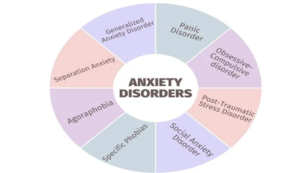Practical tips and exercises on managing anxiety symptoms from a Clinical Psychologist
Anxiety is a human response to any situation that tends to create a sense of internal conflict in an individual, usually of uncertainty, being unable to decide leading to an ultimate panicky state.
This is accompanied with physical symptoms as well that exacerbates the feeling and stimulates the irrationality of the way the situation is perceived by the individual altogether.
Some anxiety experienced always helps and acts as a precursor for attaining success such as feeling anxious before attempting an important exam or giving a public speech. These are normal human reactions however, when they step over a certain boundary wherein an individual concretely struggles to move ahead, it is problematic and seeking help becomes necessary. This is when anxiety disorders are clinically diagnosed using a checklist of symptoms and checking against them.
Common symptoms of Anxiety:
The identification and diagnosis of anxiety disorders includes a combination of psychological and physical symptoms.
Psychological tells of Anxiety:
- Feeling a sense of panic
- Difficulty in being able to pay attention
- Losing sense of control of one’s thoughts
- Obsessing over the irrational conclusions
Physical tells of Anxiety:
- Nausea
- Cold or sweaty hands
- Muscle tension
- Insomnia
- Restlessness getting worse as time progresses
Hence, these signs more or less indicate anxiety creeping in and making it heavier and harder for an individual to cope up in a given moment.
Types of Anxiety Disorders
There are multiple types of these which are as follows:
- GENERALIZED ANXIETY DISORDER – This is as the name suggests, anxiety experienced with general activities of the day. This can include worrying over daily chores or job-related issues or finances. This is problematic when the worry and fear preoccupies an individual’s headspace almost everyday, is intense and is experienced frequently.
- PANIC DISORDER – This is where panic attacks are caused as a consequence of anxiety. This can occur by triggers in the environment around or can occur without any triggers as well. It is also common to have people share two diagnoses, one of panic attacks that can be coupled with social anxiety or agoraphobia.
- AGORAPHOBIA – This is the fear of the unknown or an unfamiliar setting that lowers the possibility of escape. Agoraphobics incline towards scenarios that they can be prepared for than the ones that they cannot like visiting open spaces with lots of unfamiliar people.
- SEPARATION ANXIETY DISORDER – This is anxiety experienced when a distance is created from loved ones. This usually includes primary caregivers with children, however, adults can also be diagnosed with this condition.
- SOCIAL ANXIETY DISORDER – This is quite self explanatory as it is related to fear and anxiety of social situations. This arises due to the belief people hold of being watched and judged by others.
- SELECTIVE MUTISM – This is when one chooses to stay muted or shut during conversations driven by excessive underlying anxiety. It is not restricted to specific age groups, and can affect anyone and everyone.
How to cope Anxiety?
Anxiety Coping mechanisms from a clinical psychologist in Gurgaon lens. A Simple voluntary measures to manage anxiety first hand
- Breathing exercises performed with an instructor
- Journalling the unrealistic fears
- Frequent trustful vent outs, such as talking to a friend about this emotionally unsafe space
- Engaging in physical activities
Therapy and techniques with the assistance of a Clinical psychologist
Clinical Psychologist in Gurgaon would suggest a few therapy techniques for anxiety management.
- CBT: Cognitive Behavioral therapy is the most common therapy modality that can perhaps promise a sustainable recovery ahead. This is all about working on recognising the faulty thought patterns and attempting to modify them to eventually normalize the triggers that kick in anxiety for the client.
- Exposure therapy: This is a realistic approach to changing the optimum of the perception attached towards the thing or activity that causes fear and anxiety. This is done gradually wherein the individual is exposed to the anxiety provoking stimuli in differing intensities beginning from a slight presence and increasing it along several trials. This helps realize and change the beliefs attached to that stimulus over time.
- Grounding technique: This is also known as the 54321 method where the client is asked to remain awake in all the 5 senses. They are instructed to name five things they can see, four things that can be touched, three things they can hear, two things they can smell and one thing they can taste. This is practically feasible and allows for isolation of all senses leading to a zone of pure mindfulness and focus to calm down slowly.
Why CoachForMind?
- Experienced Psychologists: We are a team of licensed RCI-registered clinical psychologists. Our team is well-experienced in various forms of therapy such as CBT, DBT, Narrative Therapy, and other therapeutic techniques such as coping with anxiety from a clinical psychologist in Gurgaon.
- Personalized Approach: We are dedicated to treating our clients in the best-suited way, carefully curated as per the client’s needs, and adhering to one-on-one, client-centered therapy.
- Scientific Techniques: Our treatment plans and therapeutic methods are based on highly researched scientific findings such as CBT, DBT, and Narrative Therapy among many other therapeutic techniques used in art therapy counseling.
- Quality service: We at CoachForMind ensure quality services in our treatment regime and therapeutic approaches. Our clients hold most value to us, so we ground our techniques in empathy while maintaining professionalism.
For more information, please visit our website or contact us directly at coachformind@gmail.com








